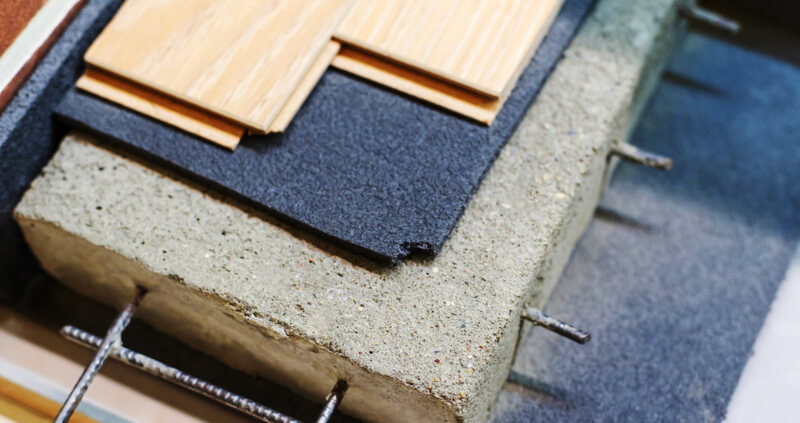
A decoupling membrane prevents newly laid tiles from cracking and lifting due to movement of the substrate or foundations below.
Decoupling membranes are laid between the tiles and the surface underneath and act as a buffer when the substrate moves. This stops tension and stress reaching new tiles which would otherwise crack, lift or debond.
Laying down a decoupling membrane is a common and important part of building and renovation projects and they are highly recommended when laying a new tiled floor.
How Does a Decoupling Membrane Work?
By laying a decoupling membrane between a foundation and tiles provides a protective barrier between the foundations and freshly laid tiles. The membrane creates a durable separation layer between the substrate and the tiles which minimises any movement and prevents gaps and cracks from forming.
Adding a decoupling membrane is likely to increase the initial cost of installing a tiled floor. However, over time it optimises the performance of the floor itself, reduces overall maintenance costs, minimises cracks in grouting and extends the lifespan of the newly laid tiles or floor surface.
Decoupling membranes are essential in certain installation projects including those with metal or asphalt substrates as tiles don’t adhere to them so easily.
Are Decoupling Membranes Suitable for all Floors?
Yes, decoupling membranes are suitable for all floor types. They are particularly effective in new build dwellings where the foundation structure is prone to movement as it settles into the ground.
Newly laid screeds or concrete can contain a large amount of moisture. As this evaporates it causes the screed to shrink and move. The decoupling membrane absorbs these lateral movements which prevents tiled floors from lifting, cracking and becoming damaged.
The innovative design of decoupling membranes provides further protection for newly tiled floors by spreading the stress caused by heavy loads, thus avoiding cracking.
When carrying out building work, decoupling membranes are also suitable for:
Underfloor heating systems
Adding underfloor heating to your building project is an ever-popular choice when it comes to choosing energy efficient heating options. However, it’s important to include decoupling membranes when installing tiled floors in properties with underfloor heating systems. The membrane presence prevents cracks appearing as the floor expands and contracts when heating is turned on or off.
Including decoupling membranes between heating elements and tiles also helps to distribute heat more evenly across a tiled floor which eliminates the possibility of hot and cold spots and improves energy efficiency.
As underfloor heating becomes a more popular choice of energy efficient heating, more flexible options are becoming available, some decoupling membranes are specifically designed to be combined with underfloor heating systems. With this solution the heating cables are incorporated into the decoupling membrane providing a convenient, all-in-one heating and decoupling product.
Bathrooms and wetrooms
A wide variety of decoupling membranes feature waterproofing properties which increase durability and makes them suitable for bathrooms and wetrooms.
Most building materials expand and contract due to changes in temperature. Bathrooms and wetrooms are often subject to dramatic changes in temperatures, they naturally tend to be colder rooms that experience sharp increases in temperatures when showers and baths are in use, generating high levels of steam and moisture. These dramatic temperature shifts combined with higher levels of moisture can impact bathroom or wetroom substrate where any movement could result in cracked tiles and grout joints.
Adding a decoupling membrane to your bathroom or wetroom floor structure will allow for this ‘movement’ caused by expansion and contraction to ensure the movement is isolated and won’t compromise the performance of your tiles.
As underfloor heating has become more popular in bathrooms and wetrooms, decoupling membranes offer a range of benefits for any installation project and can be used with numerous substrates including timber and concrete.
Is a Decoupling Membrane the Same as an Uncoupling Membrane?
No, a decoupling membrane is not the same as an uncoupling membrane as the two products perform different tasks.
We have already explained that decoupling membranes neutralise tensions between floor tiles and the substrate below. Uncoupling membranes are designed to prevent stress cracks from spreading to a finished tiled surface and causing irreparable damage.
An uncoupling membrane acts as an intermediate layer or a ‘breaker’ between the load bearing substrate and the floor covering above. It absorbs movement and lateral stress between the substrate and tiles, but it is not designed to combat differential vertical movement, otherwise referred to as deflection.
It is natural for substrates to expand and contract with changes in temperature and moisture levels. An uncoupling membrane allows surfaces to move independently so that any stress cracks that appear in the substrate are not transferred to the finished floor surface.
Uncoupling membranes are designed for use with a variety of substrates including concrete, timber and both gypsum-based and cement-based screeds.
How Do You Secure a Decoupling Membrane?
A high-quality adhesive is recommended for the fixing process for decoupling membranes as this will produce the best results over time.
When fitting to wood use a serrated trowel then apply a ribbed, adhesive bed over the wood to secure the fabric fleece on the underside of the decoupling membrane. Sufficient adhesive must be applied at this stage in order to keep the membrane in place. Once this is done, lay your decoupling membrane onto the tacky adhesive layer and press down firmly so the membrane falls into place.
When using decoupling membrane in areas where waterproofing is required such as a wetroom, any joints between the membrane should be sealed with a specialist waterproof adhesive. Similarly, if fitting to a solid floor a powder adhesive is recommended.
Unsure How to Apply Decoupling Membrane in Your Wetroom?
Our teams here at CCL are experts in wetroom design and installation and can help you create the perfect wetroom floor that will last for years to come. today. Our team are on hand and happy to help you with any questions you may have. Get in touch.









